Onion farming can be profitable with significant earnings but it takes careful planning and execution. According to the USDA, onion production in the United States generated over $886 million in cash receipts in 2020. Success in onion farming depends on soil quality, seed selection, irrigation, and pest control.
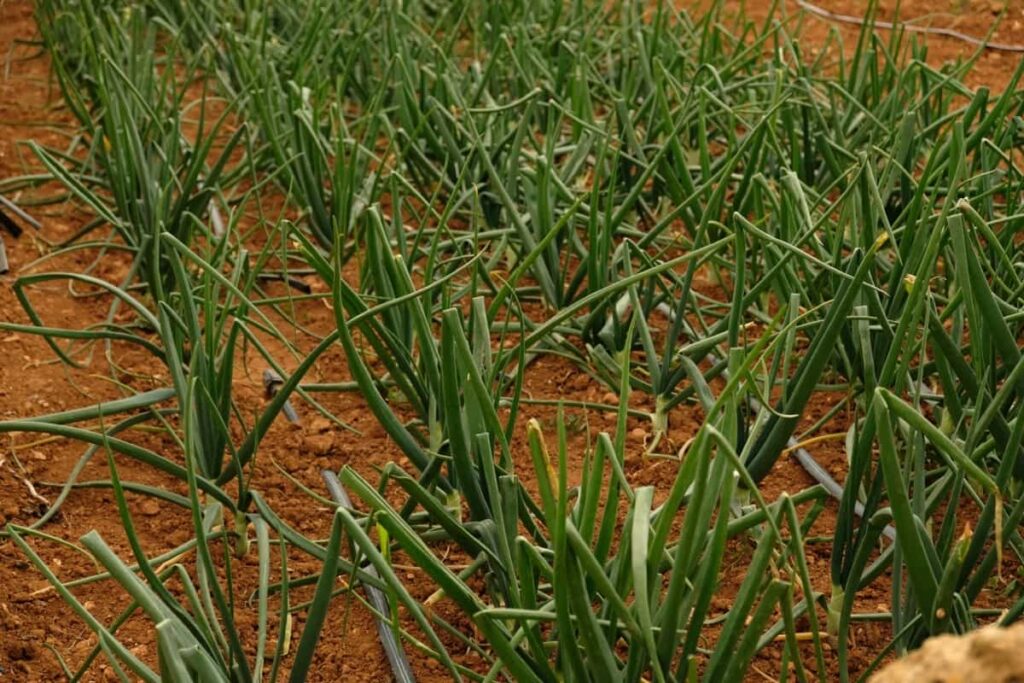
A well-crafted onion farming business plan can help maximize profits by outlining efficient production, marketing, and sales strategies. For instance, selecting the right onion varieties based on market demand and crop management practices can significantly increase yield and quality. In this ultimate guide, we will explore the essential elements of an onion farming business plan and provide practical tips for maximizing profit.
Onion Farming Business Plan
Introduction to Onion Farming
Onion farming is the cultivation of the Allium cepa plant, which belongs to the Liliaceae family. Onions are grown for their bulbs, which are produced annually. The leaves of the onion plant are semi-cylindrical or tubular in structure and have a waxy coating on the surface. The stem can grow up to 200 cm in height, and flowers appear at the tip of the stem, which are greenish-white.
The onion bulb has several layers of overlapping surfaces around a central core and can expand up to 10 cm in diameter. Onions are an important crop worldwide and are used in various cuisines for their distinct flavor and aroma. They are also rich in antioxidants and have several health benefits.
Benefits of Onion Farming Business
- High profitability: Onion farming can be highly profitable, especially in large quantities.
- Market demand: Onions are widely used in various cuisines worldwide, making them popular.
- Multiple uses: Onions can be used in various forms, such as fresh, dehydrated, and powdered, making them versatile and suitable for different markets.
- Low input costs: Onion farming requires relatively low input costs, making it an attractive option for small-scale farmers.
- Drought resistance: Onions are drought-resistant crops and can withstand periods of low water availability.
- Long shelf life: Onions have a long shelf life, making them suitable for storage and transportation, reducing the risk of spoilage.
- Health benefits: Onions are high in antioxidants and have several other health benefits, including reducing the risk of heart and certain types of cancer diseases.
In case you missed it: Growing Onions Organically in Maharashtra: Cultivation Practices and Production Management
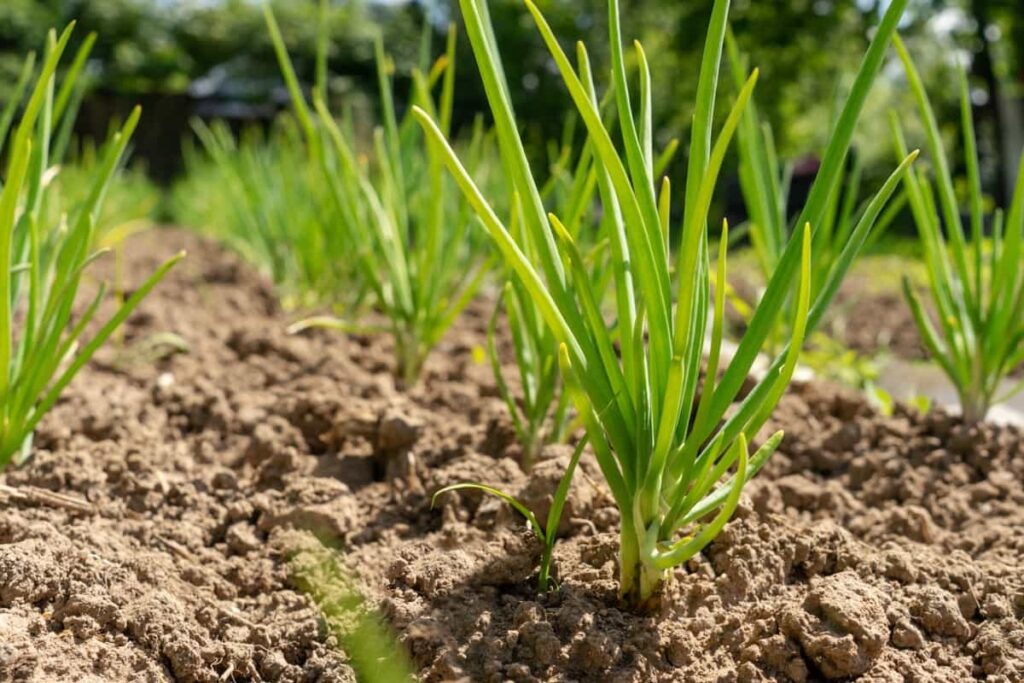
Popular Types of Onion Varieties
- Red onions: These onions have a deep red-purple color and a sweet, mild flavor. They are commonly used in salads, sandwiches, and burgers.
- Yellow onions: These have a yellow-brown outer layer and a strong, pungent flavor. They are versatile and are used in various cuisines.
- White onions: These have a white outer layer and a mild, sweet flavor. They are used in Mexican and Southwestern cuisine.
- Shallots: These onions have a milder, sweeter flavor than regular onions and are commonly used in French cuisine.
- Spring onions: These are harvested before they mature and have a mild, sweet flavor. They are commonly used in Asian cuisine.
India’s most popular onion varieties include red, NHRDF, Pusa Red, and Agrifound Dark Red. These onions are widely grown and consumed in various dishes, including curries, biryanis, and salads.
How to Commercially Grow Onion and Production
Onion is a widely cultivated and popular vegetable crop. Commercial onion farming requires ideal soil and weather conditions, appropriate irrigation techniques, and proper intercropping and crop rotation practices. Here are some key tips and requirements for successful onion production.
Ideal Conditions and Best Tips for Onion Cultivation
- Site for cultivation: Onion is a temperate crop that requires alluvial soil to grow. Depending on the location and time of cultivation, it can be grown as short-day onions (ideal for hilly regions) or long-day onions (suitable for plains).
- Climatic conditions: The perfect climate for onion cultivation is mild and gentle, with a temperature range of 13-24°C during the vegetative growth phase and 16-25°C during the bulb development phase. Onion crops also need a relative humidity of 70% and average annual rainfall of 650-750 mm.
- The season for growing: Onions are grown as Rainy and Winter crops, and the time and season of cultivation depend on the geographical location and weather conditions.
- Soil pH: Onion can be grown in all soil types, but loamy soil with good drainage capacity and organic matter is ideal. The pH of the soil be neutral (6.0 to 7.0).
In case you missed it: White Onion Farming in India: Grow Onions Bigger, Faster and Onion Growing Duration
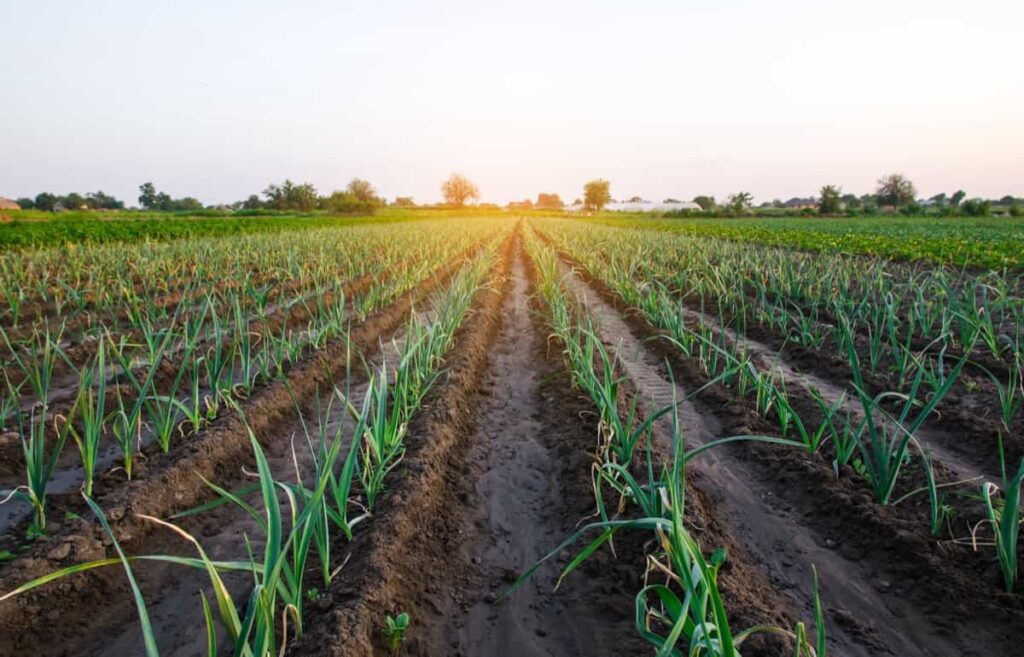
- Irrigation type: Onions require small amounts of irrigation at regular intervals to maintain optimal soil temperature and moisture for growth and bulb development. Modern irrigation methods like drip irrigation and sprinkler irrigation are used to prevent excess water loss.
- Land preparation: The last plowing should include vermicomposting or poultry manure (3 tonnes per acre). Leveling and bed preparation after plowing. Seasonally, beds might be flat or have broad bed furrows. Broad bed furrows are 15 cm high, 120 cm wide, and 45 cm deep. Flatbeds are 1.5-2 meters wide and 4-6 meters long. Onions are grown in broad bed furrows in rainy and flat beds in winter.
- Onion planting: After 30–40 days in nurseries, onion seedlings are transported to fields. Onion cultivation requires nursery management and transplanting.
- Nursery management in onion: Onion seedlings may be grown on 0.15 acres for a one-hectare main field. Plow and clod-free the nursery field. For nursery preparation, raised beds should be 10-15 cm high, 1 m wide, and convenient in length. To drain excess water, beds should be 30 cm apart. Damping-off diseases are prevented by 2g/Kg thiram or Trichoderma viride on seeds. Seedlings are placed 10 cm apart in prepared beds.
- Transplanting: Avoid transplanting over- and under-aged seedlings. Roots are soaked in 0.1% carbendazim solution for two hours after cutting one-third of the seedling’s top to manage fungal diseases. Early transplantation increases bulbs. Onion transplantation depends on place and season.
- Onion diseases and pest protection: Fungi, bacteria, nematodes, and insects can infect onions. Onion Yellow Dwarf and Irish Yellow Spot viruses are notable. Onions are vulnerable to viral diseases such as Onion Yellow Dwarf and Irish Yellow Spot, fungal infections such as Damping Off, Stemphylium Blight, Purple Blotch, and Anthracnose, and insect pests such as Thrips and Eriphyid mites. Control measures for these diseases and pests include using resistant varieties, crop rotation, intercropping, insecticide spraying, and soil treatment.
- Irrigation: Onions need frequent irrigation to grow and bulb. Growth stage and climate affect water needs. Onions need 400–500 mm of water per season. Waterlogging causes root rot and bulb deterioration, therefore altering the irrigation plan. To dry onions, discontinue irrigation two weeks before harvest.
- Fertilization: Onions need balanced nutrition for healthy growth and maximum production. To determine nutrition and fertilizer needs, test the soil. Soil type, crop rotation, and other factors affect fertilizer schedules. Onions need 1:1:2 nitrogen, phosphorus, and potassium. Fertilizers should be separated during the growing season. Farmyard, vermicompost, and poultry manure are organic fertilizers.
In case you missed it: Hybrid High Yield Onions Varieties in India: For Rabi, Kharif, Late, and Early Kharif
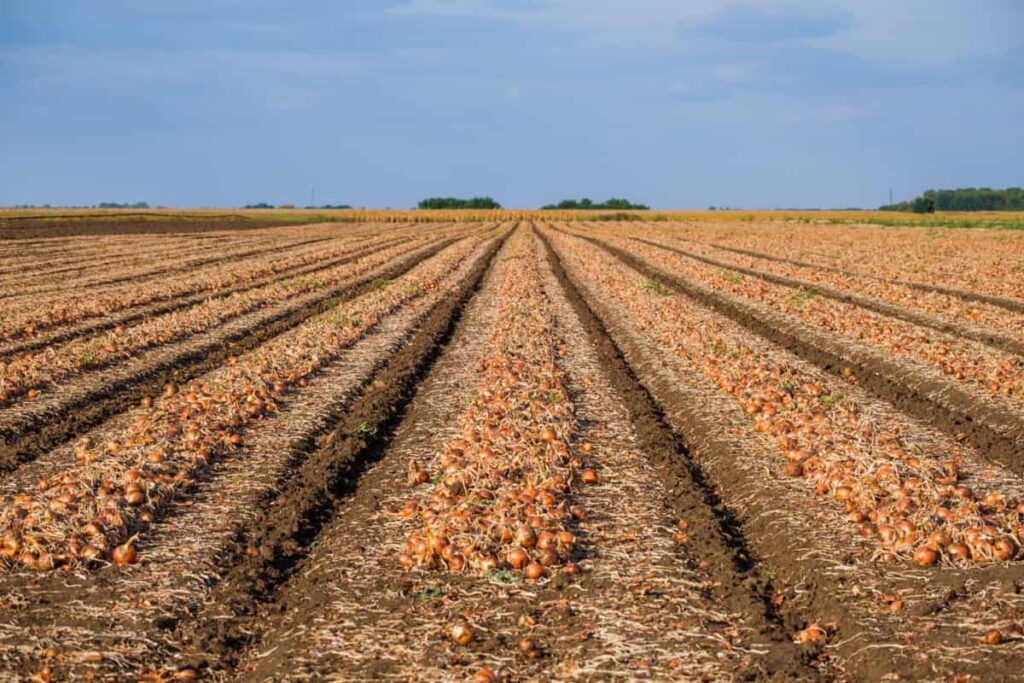
- Harvesting and grading: Onion harvesting is done by gently pulling the plants from the soil when the green tops start drooping. The bulbs are then cleaned, dried in the shade for four days, and graded based on the size as A (above 80mm), B (50-80 mm), and C (30-50 mm). The grading process is done manually or by machines.
- Storage: Properly stored onions last several months. Onions should be held at 0-1°C and 65-70% humidity. Onions should be stored in a well-ventilated environment to control mold and moisture. Sort and grade bulbs before storing them. Remove infected bulbs.
Project Report on Onion Cultivation
Onion cultivation is an important aspect of agriculture for commercial and subsistence farming. This project report aims to provide an overview of onion cultivation, including its history, cultivation methods, and the varieties commonly grown onions. This report will also cover important aspects such as soil preparation, planting techniques, pest and disease management, harvesting, post-harvest handling, production cost, returns, and profits. Additionally, the report will touch on the economic importance of onion cultivation, including its impact on global food security and farmers’ livelihoods.
Cost and Profit Report of Onion Cultivation
Cost of Production
The cost of production for onion cultivation can vary depending on several factors, such as the size of the farm, the variety of onions grown, and the farm’s location. In the USA, the cost of production per acre for onion farming can range from $3,000 to $6,000, while in India, it can range from INR 45,000 to INR 65,000 per acre. The major components of the cost of production include land preparation, seed cost, labor cost, irrigation, fertilizers, and pest management.
The total cost of onion cultivation was found to be the highest in the labor component, which accounted for 43.5% of the total cost. Following this came the cost of fertilizers, which comprised 25.9% of the total cost, and the cost of seeds, which included 10.8%. Other expenses, such as irrigation, land rent, and insecticides, accounted for 19.8% of the total cost.
In case you missed it: Pig Farming Project Report: Investment, Profit for 10, 20, 50, 100, and 500 Pigs/Hogs
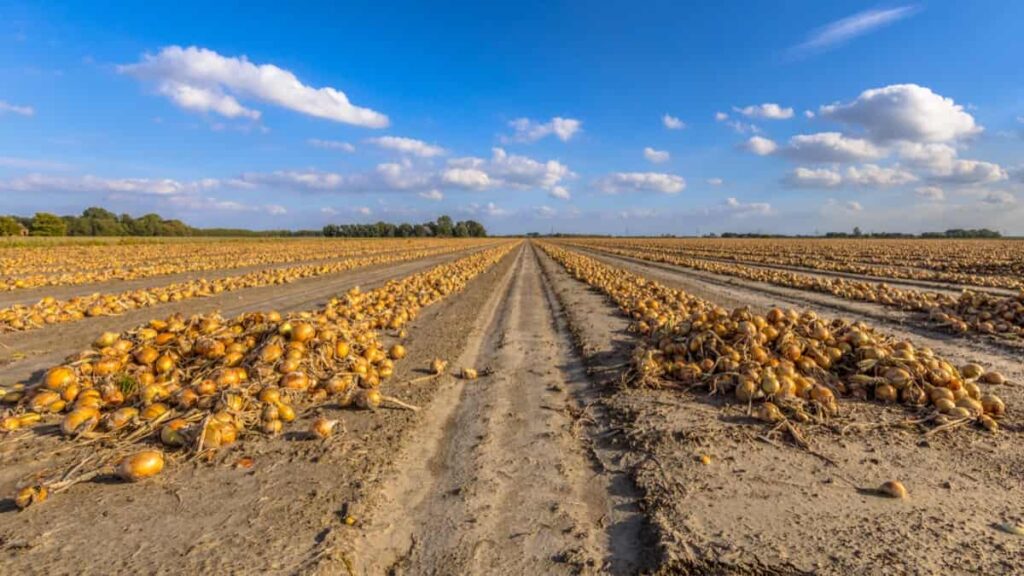
Returns
The returns on onion cultivation largely depend on the yield and the market demand for onions. The average yield per acre of onions in the United States is around 15-20 tons; in India, it is about 10-12 tons per acre(It may vary based on variety). The market prices for onions can vary greatly depending on demand and supply, ranging from $0.20 to $0.50 per pound in the United States and INR 5 to INR 15 per kg in India(It may reach as high as 60-120 at peak season).
Profits
The profits from onion cultivation can be attained by subtracting the cost of production from the returns. In the United States, the profit per acre can range from $5,000 to $10,000, while in India, it can range from INR 80,000 to INR 160,000 per acre.
Market Research and Analysis of Onion Farming Business
Due to the great demand for onions in domestic and international markets, growing onions is an economic enterprise. In 2020, global onion output hit 105.4 million tonnes, as reported by the Food and Agriculture Organization (FAO). The United States and China are the next two major producers of onions, after India. Onion yields range from 20 to 25 tons per hectare, depending on climate and growing practices.
Onions are in high demand because of their versatility in cooking. The United States, Germany, the UK, and Spain are among the largest importers of onions. Demand for onions in the food industry is estimated to propel the worldwide onion market to expand at a CAGR of 3.5% between 2021 and 2026. The production and demand for onions fluctuate due to external factors like climate, pests and diseases, and consumer demand. High-quality onion production is essential for farmers in today’s cutthroat market.
Onion Farming Business Plan
A successful onion farming business plan requires careful planning and execution. The plan should include various components, such as market analysis, financial projections, and production planning. The market analysis should identify target markets, competitors, and demand trends. Financial projections should include startup costs, revenue projections, and cash flow analysis. Production planning should cover cultivation methods, seed selection, pest and disease management, harvesting, and post-harvest handling.
The plan should also address marketing and sales strategies, risk management, and legal and regulatory compliance. By developing a comprehensive onion farming business plan, farmers can set clear goals and objectives, mitigate risks, and maximize profitability. A well-executed business plan can help farmers secure financing, attract customers, and establish a successful onion farming business.
Business Plan Components of Onion Farming
A successful business plan for onion farming should include several important components. Firstly, an executive summary should be included that provides a brief overview of the business and its objectives. This should be followed by a market analysis identifying the target market, market trends, and competition. The next component should describe the onion farming operations, including the cultivation methods, equipment, and labor requirements.
In case you missed it: From Seed Selection to Successful Business: Crafting a Comprehensive Avocado Farming Business Plan
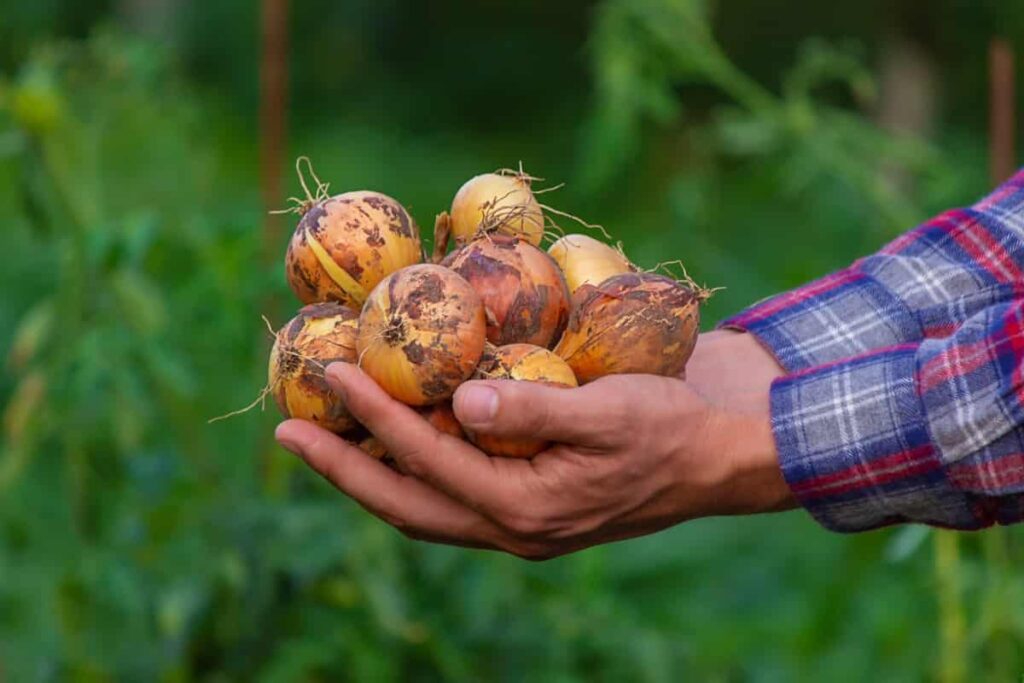
This section should also include information on the variety of onions to be grown, the expected yield per hectare, and the estimated production costs. The financial analysis section should be included, which outlines the startup costs, cash flow projections, and profitability analysis. This should include a detailed breakdown of production costs, such as land, labor, seeds, fertilizers, and irrigation systems. A marketing strategy should also be included that outlines how the onions will be sold, such as through direct sales to retailers or wholesalers.
This should include a pricing strategy and promotional activities such as advertising and social media marketing. Risk analysis and management should also be included, identifying potential risks such as adverse weather conditions, pest and disease infestations, and market fluctuations. This section should also outline strategies to mitigate these risks and protect the business from financial losses. Lastly, a management team section should be included, outlining the roles and responsibilities of the key personnel involved in the onion farming operations.
Conclusion
A well-thought-out business plan is needed for an onion farm to be successful. Farmers can improve their maximize and accomplish their objectives with the help of market research, financial forecasts, risk mitigation techniques, and a comprehensive marketing plan.
- Crops Grown in Summer Season: Best Choices for Summer Gardening
- Organic Pest Control for Tomato Farming
- How to Maximize Sheep Farming Profit
- Broccoli Varieties: Choosing the Right Cultivars for Your Farm
- How to Raise Pigs in Your Own Backyard: A Comprehensive Guide
- Budget Friendly Sheep Shed Ideas: Cheap and Low-Cost Tips
- How Much Do Cattle Farmers Make: Revenue Streams in Cattle Farming
- Management Pests and Diseases in Your Cotton Field
- Sheep Farming Business Plan for Beginners
- Aquaponic Farming at Home: A Step-By-Step Guide
- Profitable Village Farming Business Ideas in 2024
- High-Yield Aquaculture: Fast-Growing Fish for Farming
- Effective Fish Pond Construction Techniques for Beginners
- Irrigation and Water Management in Pineapple Farming
- Blossom to Harvest: Mastering Flowering and Pollination in Papaya Farming
- Pig Fattening Essentials: From Selection to Sale for Beginners
- Raising Wagyu Cattle: A Complete Guide for Premium Beef Production
- Soil Types and Their Water Holding Capacity
- Optimizing Irrigation Schedules for Coconut Groves for Enhanced Yield
- Espresso Your Garden: Coffee Grounds for Healthier Acid-Loving Plants
- The Best Soil Mix for Snake Plants: How to Mix Your Own Snake Plant Soil
- Green Thumb Success: Expert Tips for Cultivating Greenhouse Beans All Year Round
- Bloom All Year Round: The Ultimate Guide to Indoor Hyacinth Care
- Eco-Friendly Gardening: How to Make Liquid Fertilizer from Kitchen Waste
- Ultimate Guide to Grow Anise in Pots: Explore Seed Propagation to Harvesting
- Guide to Raising Chester White Pigs: Discover Breed Facts to Growth Management
- Mastering the Elegance: The Ultimate Guide to Weeping Cherry Tree Care, Planting, and Maintenance
- Ultimate Guide to Planting Garlic in Grow Bags: Growing Strategies for Beginners
- How to Fix Spider Plant Leaf-Related Problems: Natural and Organic Remedies
- 10 Reasons Why Your Tulsi Plant is Shedding Leaves: Home Remedies and Solutions
- Optimizing Growth and Yield: The Advantages of Palm Bunch Ash Fertilizer
- Utilizing Neem Oil Extract as a Natural Pesticide for Hydrangea
- From Soil to Harvest: Various Ways in Which Farmers Can Use AI Tools
- Steps to Encourage and Induce Citrus Flowers: A Comprehensive Guide
- How to Fix Snake Plant Leaf-Related Issues: Natural and Organic Remedies
- Transform Your Garden into a Fragrant Oasis with Raat Ki Rani (Night Blooming Jasmine)
